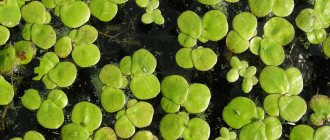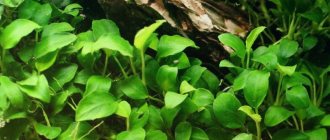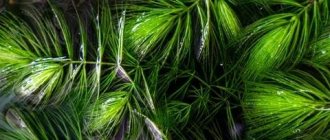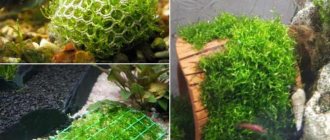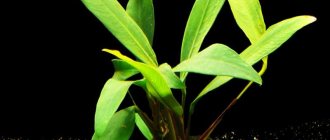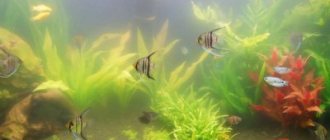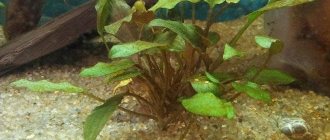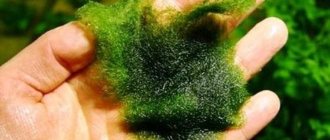Varieties
Small species are kept in aquariums. A water lily grows as a bush under water. Forms flowers on the surface if conditions are created for this.
Red water lilies
Red nymphea has olive or red leaves and maroon patterns. The origin has several versions. The first claims that the red nymph is a native of West Africa. The most popular theory is that the water lily was bred artificially for the needs of the aquarium.
Burgundy nymphs
The plant received its name for its purple leaves. The height does not exceed 40 cm. For the normal development of large leaves, provide the bush with enough free space.
Green tiger nymphs
Large leaves are bright green with dark patterns. During flowering, a white flower appears. Nymphea tiger is often found in aquariums.
Nymphea rudge
The color of the leaves is pinkish-green, the shape is round. The number of leaves is formed in accordance with the volume of the aquarium. Flowering is accompanied by a small white flower. In winter, growth slows down greatly.
Nymphea micrantha
It grows on average up to 30 cm in length. Forms leaves underwater and on the surface. Underwater sheets are painted red-green, surface sheets are solid green. The appearance of floods signals the speedy appearance of the flower.
Nymphea viviparous
The leaves of this plant are light green above and have purple spots below. The bush looks impressive in an aquarium. The viviparous water lily is less picky about water parameters.
Tiger (green) nymph
The simplest plants that do not require constant attention are green nymphs. Planting and caring for them can be done well at home. This water lily can grow up to sixty centimeters. It grows and multiplies quite quickly, so it is necessary to get rid of new shoots in a timely manner.
The leaves of the plant are small in size and do not grow very quickly, being located over the entire area of the aquarium. The leaves of tiger nymph grow on tall petioles that come from the very powerful root system of the plant. Their appearance is quite standard for the genus of nymphs; they have small slits in the center.
The leaves can reach enormous sizes only if there is not enough water in the aquarium. Such plants are very reminiscent of the most common water lilies that are found in reservoirs and ponds.
This type of plant can begin flowering directly in the aquarium. It produces a large white nymphea flower of unusual beauty, opening mainly at night. Planting and care, growing this crop from seeds is not particularly difficult, since the seeds that fall into the ground and ripen after flowering quickly begin to germinate and develop.
Tiger nymphs can also reproduce vegetatively. For the normal development of this plant, it must be fed with special feed, which should contain a large amount of useful microelements.
Contents and terms
Nymphea cannot be called an unpretentious aquarium plant. You will need additional equipment and powerful lighting. Growing water lilies requires experience in maintaining aquarium plants.
Landing
To plant a nymph, you will need an aquarium at least 50 cm in height, filled with at least 40 cm of water.
Water
The water lily will need soft water (2–14 dGH). In a more rigid one, the nymph will exist without flowering. pH value 5–7. The water lily does not like frequent water changes. It’s better to do 20–25% once every two weeks.
Temperature
Nymphea survives at temperatures from 15 to 30 degrees. Blooms from 22 degrees.
Microclimate
Maintain the microclimate of the aquarium. Take care of heating the water in cold weather. A thermometer is required. The presence of oxygen dissolved in water is desirable. To do this, place a low-power compressor or pump. Make sure that the aeration process does not shake the water too much.
Priming
Use a soft substrate. Combine in the mixture:
- clay;
- small pebbles;
- peat;
- black soil;
- sand.
Top dressing
For feeding, use fertilizers and additives:
- mineral;
- humic acids;
- iron salts;
- bone meal.
During the growing season, increase the dosage of fertilizers. In an aquarium with an established biological environment, it is not necessary to feed the plant. Yellowing leaves indicate a lack of nutrients, so take a closer look at the appearance of the plant.
Lighting
Place lighting fixtures at a sufficient distance from the surface of the water. Avoid using incandescent lamps: they are low wattage and heat up the water too much. LED and fluorescent lamps are suitable. The plant benefits from sunlight, but in the aquarium, under the influence of such light, weed algae develop. Create 12-14 hours of daylight.
Sensitivity to light
It is very important to be informed about the fact that the aquarium tiger nymph, which is generally not difficult to plant and care for, is quite sensitive to light. When the plant does not have enough light, the stems of its leaves will begin to gradually rise up and weaken. After a couple of days, the leaves will change their bright green color to a duller one, which can result in the death of the water lily.
In order to prevent such an outcome of events, it is worth extending the exposure of the nymph to sunlight from ten to twelve hours a day. During this time, she will be able to receive enough vitamin D and develop in the right direction. When it is not possible to enjoy real light during the day, fluorescent lamps come to the rescue; in this case, phytolamps will have the best effect. Using them allows you to increase the growth rate of plants, if this is, of course, necessary for the owner of the flower.
Reproduction
Nymphea reproduces in two ways:
- Root shoots. After flowering, the root of the plant increases in width. Separate the new growths and place them in a previously prepared aquarium with soil and water at a temperature of at least 26 degrees. Thinning thickets is beneficial for nymphs.
- Seeds. Artificially pollinate the plant in the fall. To do this, treat the leaf axils with a soft brush. After the seeds form, collect them and place them in a peat substrate, watering them with warm, settled water. If the conditions are met correctly, the first shoots appear. The seedlings are placed in different places.
Methods for propagating nymphs
The plant is characterized by two methods of reproduction. The first occurs using seeds, and the second is a vegetative method. In this case, new small shoots will appear on the roots of the plants. If their growth begins to exceed fifteen centimeters, then it is recommended to transplant them into a separate aquarium or pot filled with soil.
Not everyone knows that newly formed shoots adapt very slowly to new living conditions. Therefore, if there are no plans to breed this plant in the future, then it is best to get rid of the shoots that appear on the roots in a timely manner.
If a nymphea lives in a flower pot, then its location must be changed after a certain period of time. Spring is best for this. It is during this period that the water lily is in a state of quiet growth. Therefore, changing her place of residence will not harm her in any way.
Being an ordinary plant, nymphs, planted and cared for in a home aquarium, nevertheless, necessarily require feeding with useful fertilizers. It is best to use supplements that contain high amounts of iron for this. This element has a beneficial effect on the development of water lilies.
Nymphea in nature
Under natural conditions, the water lily prefers swamps and ponds. Natural specimens are divided by size:
- miniature;
- average;
- large;
- gigantic.
Bushes that grow up to 70 cm in height are considered small; the largest ones grow up to 1.5 m. The size of the petioles depends on the place of growth. Some water lilies are awake during the day, others show buds at night. There are flowers that are simple in structure, others have a huge number of petals and resemble asters and peonies.
Flower colors vary:
- red;
- lilac;
- pinkish;
- white;
- yellow;
- orange.
Natural representatives have powerful root processes up to 5 cm in diameter. There are species adapted to winter cold (pure white, white, small), but most cannot tolerate cold winters.
Appearance Features
Despite the fact that there are several varieties of nymphea, they all have some similar features that are characteristic of this particular plant:
- Size . The height of an adult specimen when grown in an artificial reservoir can range from 20 to 70 cm. The size of the nymph depends on the volume of the aquarium, as well as the conditions of maintenance and care.
- Rhizome . The plant has a strong, well-developed and tenacious root system.
- The stem is straight and strong.
- Leaf plates are the main advantage and decoration of the nymph. The leaves have an unusual shape that resembles hearts. The color is dominated by different shades of green. A unique feature is that the underside of the leaf turns purple when exposed to ultraviolet radiation. Less common are varieties of nymphea with burgundy, white leaves that have a rounded or, conversely, elongated shape.
- Flowers. Under favorable conditions, nymphea blooms not only in nature, but also in artificial habitats. The flowers have a delightful pastel pinkish color and a very beautiful shape. The flowering period occurs mainly in the summer (late July - early August).
The decorative qualities of the nymphaeum, beautiful flowers and surprisingly bright leaves have made it one of the favorites among the creators of aquarium design.
Recommendations for beginners
- Before placing the water lily in the aquarium, make sure that the conditions for comfortable growth are created.
- If the plant is planted in an aquarium with fish, check whether the required water parameters are similar. Remember that fluid changes for fastidious fish are carried out once a week. Such frequent changes of water injure the plant.
- Avoid sudden changes in temperature and water parameters. This is harmful to the flora and other inhabitants of the aquarium.
- Rocks and shells increase the hardness of the water in the aquarium. Such decorations can cause a lack of flowering.
- If the water lily does not bloom or dies, and the cause cannot be determined, contact experienced aquarists. Perhaps they will help find a way out of the situation.
Nymphea is a beautiful aquarium plant that requires patience and skill. And although experienced flower growers understand the intricacies of keeping them, some mistakenly call the nymphea a capsule, the bushes of which can grow in the shade, and flowering is accompanied by small yellow flowers.
Previous PlantsFeatures of keeping liver mosses in an aquarium Next
PlantsTOP-32 unpretentious aquarium plants
Conditions of detention
Nymphea is not too demanding in terms of care. But you will have to pay attention to creating certain conditions for its existence, because otherwise it will quickly lose its beauty, begin to get sick and may even die before it has time to fully develop. Suitable conditions for nymphs:
- Aquarium dimensions . Considering the fact that almost all types of nymphs are large in size, the aquarium, accordingly, should be spacious with high walls (from 45 cm).
- Water parameters : temperature - from +22 to +30°C, hardness - from 2 to 4 dGh, acidity - from 6 to 6.5 units.
- The soil . The ideal soil for growing nymphs will be small pebbles with the addition of clay impurities. An alternative could be a peat-clay mixture enriched with humic acids.
- Lighting . For normal development of nymphs, intense and bright lighting is required. With a lack of light, the stem begins to stretch in length, fades, and the plant stops blooming. But it is not recommended to use too powerful lighting devices and place them near the water surface, as this can lead to severe burn injuries to the nymph. An excellent option for lighting would be fluorescent or phytolamps. The average duration of daylight is about 8-10 hours throughout the day.
- Accommodation . Spreading and tall nymphs are recommended to be planted at the back walls or in the corners of an artificial reservoir. This will allow you to create a beautiful design, while maintaining a sufficient amount of free space and avoiding shading, which can be detrimental to other plant crops and ornamental fish.
- Replacing water . Nymphea feels comfortable in stagnant water. Therefore, if filtration and aeration are available, it is recommended to replace the liquid in the aquarium more often than once every 3 weeks by 20% of the total volume of water in the tank.
- Feeding. Nymphea needs additional fertilization. Lack of certain nutrients negatively affects her health and appearance. It is recommended to give preference to formulations enriched with a high content of iron and minerals. If the leaf patina of the nymphea begins to acquire a yellow color, this is a signal indicating that it is time to feed the plant with fertilizers.
Nymphea cannot be called a plant that is too difficult to grow, but it is not suitable for beginners.
The most important thing for this plant is to maintain certain parameters of the aquatic environment.
In hard water, the nymph stops flowering and begins to grow in width.
How to keep a nymph in an aquarium?
According to the general opinion of aquarists and florists, keeping Nymphaea lotus in an aquarium is not so easy. It can be classified as a fastidious aquatic plant. There are often cases when, if care requirements were not met, a young nymph died before it had time to develop.
For a normal life of this bright representative of aquatic flora, you need a fairly deep aquarium, with a water column height of at least 45 cm.
Stiffness is an important indicator that influences its development. It is believed that a soft - from 2 to 4 degrees - slightly acidic habitat with an acidity of 6-6.5 pH is suitable for Nymphaea lotus. Therefore, humic acids are sometimes added to the soil (in the form of commercial fertilizers).
However, even in hard water, the lotus will grow, but only in breadth, gradually turning into an underwater bush with small leaves. Such a bush will no longer bloom.
Thus, the appearance of the nymph and its ability to flower completely depend on the desires and skills of its owner.
Since in nature water lilies prefer stagnant water, changing the contents of the aquarium too often is not so important. Rather, they are undesirable, since this vegetation loves old water, rich in organic decay products.
Once every 3 weeks you can replace up to 20% of the existing total volume. This circumstance must be taken into account when breeding one or another type of ornamental fish.
The optimal temperature for lotus nymphs is +28 degrees, as in tropical conditions. Its reduction is permissible to +22.
At lower temperatures, the water lily sharply slows down its growth, and flowering becomes impossible. It is advisable to maintain the temperature without sudden changes in one direction or another.
Weekly feeding of the plant with mineral fertilizers containing iron salts is very important. Without this, the lotus leaves may turn yellow.

